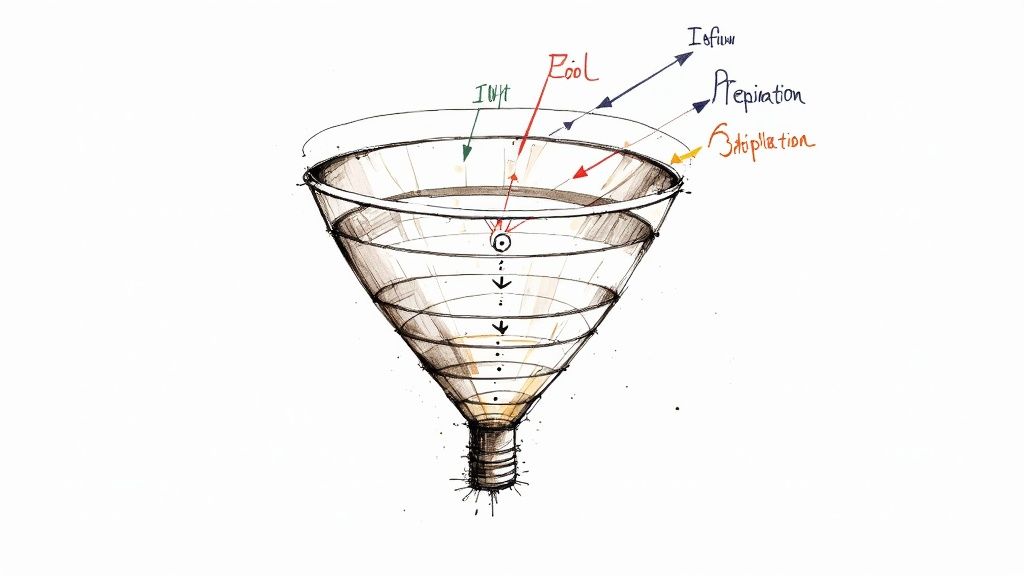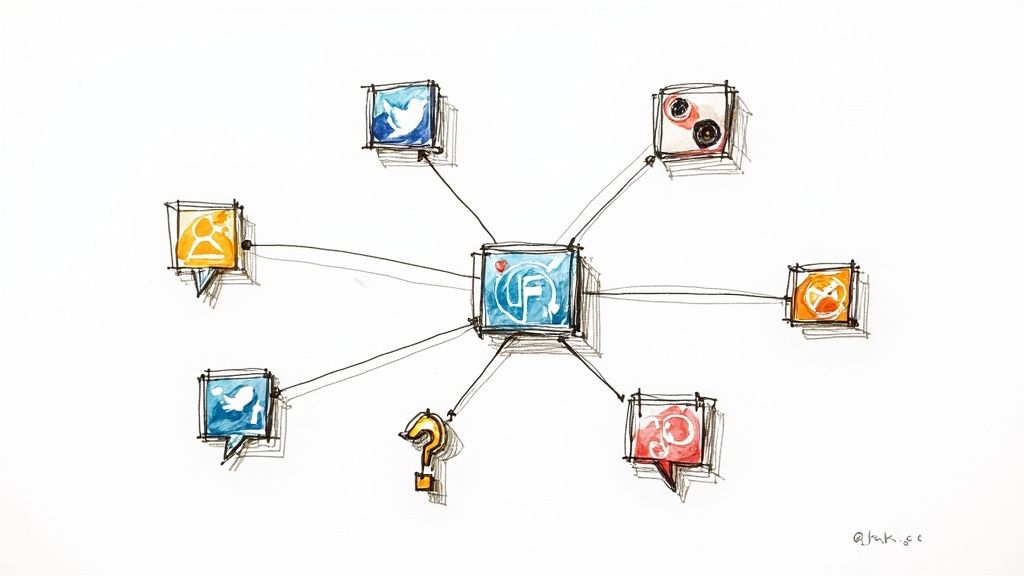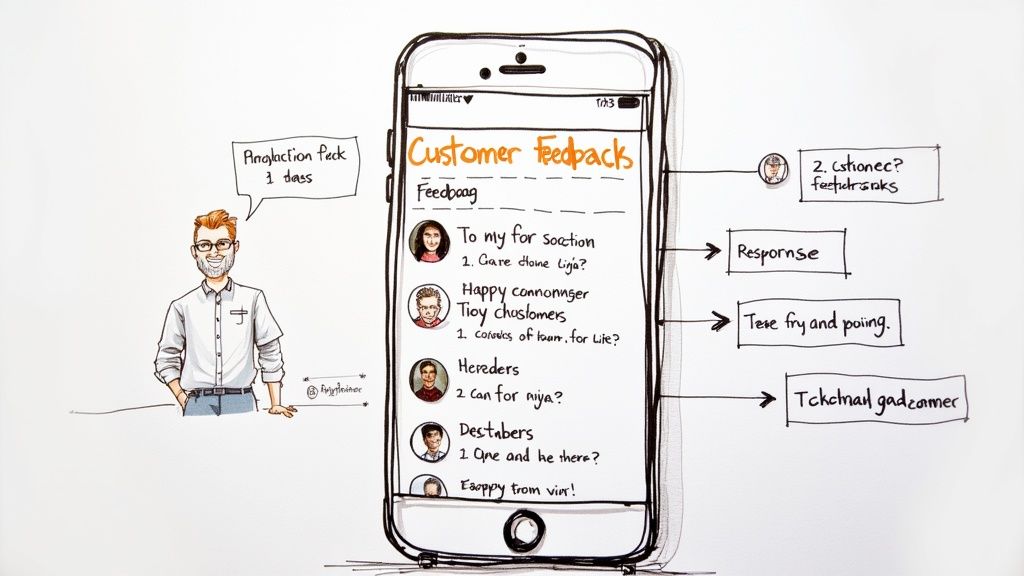10 Best Reputation Management Tools: A Complete Guide for Brand Protection
Discover field-tested reputation management tools that protect and elevate your brand online. Learn from industry experts how to select, implement, and maximize ROI from reputation monitoring solutions that deliver measurable results.
- 9 min read

Understanding Modern Reputation Management Tools

Building a strong online presence requires active management of how customers see and talk about your business. Smart reputation management isn't just about handling negative reviews - it's about creating lasting customer trust and maintaining a positive brand image that resonates with your audience.
Getting the right tools makes all the difference. The best reputation management tools bring together everything you need to watch, understand, and guide online conversations about your brand. These systems help you spot issues early, improve customer experiences, and build a stronger brand presence.
Meltwater shows what modern tools can do - it tracks mentions across 300,000 news sources and 200 billion social conversations in real-time. This wide coverage helps catch potential issues before they grow. The platform also connects you with 35 million influencer profiles and offers clear performance tracking through custom dashboards. Want to see how these numbers stack up? Check out more industry stats here.
Key Components of Modern Reputation Management Tools
Good reputation tools share some essential features that work together to give you a complete view of your brand's standing online. Here's what matters most:
- Real-Time Monitoring: Quick alerts about brand mentions let you respond promptly to feedback
- Sentiment Analysis: Understanding the feeling behind customer comments helps separate real problems from casual mentions
- Review Management: Easy tools for responding to reviews across different sites
- Reporting and Analytics: Clear data shows what's working and what needs attention
- Social Listening: Looking beyond direct mentions reveals valuable insights about your market and competitors
These features help businesses take charge of their story online instead of just reacting to what others say. This active approach builds a stronger presence that can weather challenges and grow with your business.
Essential Features of Top Reputation Management Platforms
Tracking brand mentions is just the start - effective reputation management needs robust tools that help businesses understand and act on public perception. The best reputation management tools help companies monitor their online presence while providing actionable data to manage their reputation proactively.
Sentiment Analysis: Understanding Online Conversations
Sentiment analysis is a key capability that analyzes the emotional tone behind mentions. Rather than just counting references, it interprets whether comments are positive, negative, or neutral. For instance, a news article mentioning your company name may be neutral, while customer complaints on social media are clearly negative. This helps teams focus their response efforts where they matter most.
Predictive AI: Spotting Issues Early
Modern platforms now use predictive AI to identify potential reputation problems before they grow. By analyzing past patterns and current signals, these tools can alert you to brewing issues. This early warning system lets companies address concerns before they turn into major problems. You might be interested in: How to master customer reviews.
Cross-Platform Monitoring: Complete Brand Coverage
Effective monitoring means tracking all the places people talk about your brand. Quality tools scan social media, news sites, review platforms, forums and blogs to catch every important mention. For example, Talkwalker offers customizable dashboards that show brand data alongside competitor metrics. Their Blue Silk™ AI examines mentions for context and sentiment, while also scanning for brand imagery across platforms.
Key Features to Look For in Reputation Management Tools
When selecting a tool, focus on these essential capabilities:
- Real-Time Alerts: Instant notifications when important mentions happen
- Automated Reporting: Regular reports tracking key metrics and patterns
- Competitor Analysis: Monitor competitor mentions and sentiment
- Crisis Management Tools: Features for coordinating responses during issues
- Integration Options: Works with your existing marketing and CRM tools
Picking the right reputation management platform is crucial for protecting your brand online. Look for tools with these core features to help build trust with customers and maintain a strong reputation over time.
Comparing Leading Reputation Management Solutions

Finding the right reputation management tool makes a big difference in how effectively you can monitor and build your brand online. Let's look at how different platforms handle review management, crisis prevention, and customer engagement. We'll also examine pricing and features to help you pick the option that fits your needs.
Key Features Comparison
Sprout Social excels at combining review management, social listening, and customer sentiment tracking in one dashboard. Podium takes a different approach by focusing on text-message based review collection and customer communication. Birdeye sets itself apart by using advanced analysis to spot improvement areas from customer feedback.
Here's how these platforms compare on key features:
Understanding Available Tools
Meltwater and Brandwatch focus on detailed media tracking and social analytics. Both send quick alerts when issues arise - essential for managing potential problems early. For smaller companies, Broadly offers straightforward tools to handle email marketing, review requests, and social posts.
Meltwater watches social channels and news coverage, measuring overall brand perception and flagging potential issues. Brandwatch provides in-depth analysis across social platforms to help you understand what customers are saying and how opinions change over time.
Selecting Your Ideal Solution
The best choice depends on your company's specific goals and resources. Here's a simple guide:
- Small Business/Startups: Focus on user-friendly, affordable options like Broadly or Podium that make review collection simple. kisReviews works well for basic review management.
- Growing Companies: Look for platforms like Sprout Social or Birdeye that provide deeper customer insight through detailed analytics.
- Large Enterprises: Consider full-featured systems like Meltwater or Brandwatch that offer extensive monitoring and competitive analysis.
Think about how each tool will work with your current systems and what kind of support you'll get. Consider any unique challenges in your industry and whether the platform has specific features to address them. Taking time to evaluate these factors helps ensure you pick a tool that truly fits your needs.
Implementing Your Reputation Management Strategy
So you've picked out your reputation management tools - that's just the beginning. Like any business software, these tools work best when backed by solid planning and consistent execution. Proper implementation makes the difference between having useful tools and gaining real competitive advantages.
Building Effective Monitoring Protocols
First, make a detailed list of what you'll track online. Beyond just your company and product names, think about monitoring industry terms, what people say about competitors, and mentions of key team members. This wider view helps you understand the full conversation around your brand. For example, tracking competitor discussions can reveal shifts in customer preferences and industry direction.
Set clear rules for who does what. Determine which team members check alerts and how quickly reviews need responses. Written procedures keep everyone aligned and ensure nothing important gets missed. This becomes especially important during reputation challenges when quick, coordinated action matters most.
Developing Crisis Response Playbooks
Even with careful monitoring, problems can arise. That's why you need crisis response playbooks ready before issues happen. Your playbooks should spell out exact steps for handling different threats - from negative press coverage to social media criticism to product issues. See our guide on How to master getting online reviews with email for more tips.
Good playbooks ensure everyone knows their role and follows approved messaging. This preparation helps keep small issues from becoming major problems and shows stakeholders you handle challenges professionally.
Creating Workflows That Maximize Tool Effectiveness
Connect your reputation tools with your existing systems. Link them to your customer database to track interactions better. Use what you learn from social listening to guide your content creation.
Consider how feedback flows through your company. When customers point out product problems, make sure that information reaches your development team. When you get great reviews, share them through your social channels and marketing materials as proof of quality.
Training and Accountability
Take time to properly train your team on your chosen tools. Make sure everyone understands how to read the data, write review responses, and know when to escalate issues. Set clear ownership of tasks and track results to maintain consistent quality across all reputation management work.
Check and update your strategy regularly. As online platforms and user behavior change, your approach needs to adapt too. Regular reviews help keep your reputation management effective and current with best practices.
Measuring ROI and Success Metrics

When investing in reputation management tools, measuring their impact is essential for business success. The key is focusing on metrics that directly connect to revenue and growth, not just surface-level numbers like total mentions. Let's explore how to effectively measure and track your return on investment.
Defining Key Performance Indicators (KPIs)
Start by setting up clear Key Performance Indicators (KPIs) that align with your specific business goals. Different types of businesses need different success metrics:
- Sales-focused companies should track conversion rates, leads generated, and revenue tied to positive reviews. A local business might see direct links between Google reviews and in-store visits.
- Brand-focused organizations need to measure brand awareness, market presence, and customer satisfaction levels to show how reputation efforts strengthen their market position.
- Service-oriented businesses benefit from tracking customer retention, response times, and satisfaction scores to show improved customer relationships.
Establishing Meaningful Benchmarks
Create realistic benchmarks using your past performance data to measure progress. If you're just starting out, look at industry standards as your baseline. Clear benchmarks help you evaluate if your reputation tools are delivering results. You might be interested in: Learn more about why reviews can significantly grow your business.
Tracking and Analyzing Your Results
Keep regular tabs on your KPIs and look for patterns in your data. Most reputation management tools come with built-in reporting features that make this easier. These reports help you spot what's working and where you need to make changes to get better results.
Demonstrating Value to Stakeholders
Share concrete examples of how your reputation management work impacts the business. For instance, show how a 20% drop in negative reviews led to better outcomes. Point out when a rise in positive feedback resulted in a 10% boost in sales conversions.
Building a System for Continuous Improvement
Put your findings to work by regularly updating your approach. As you collect more data and your business grows, adjust your metrics and goals accordingly. Regular monitoring helps you get the most value from your reputation management tools while meeting your long-term goals. This creates an effective cycle of learning and improving.
Future Trends in Reputation Management Tools

As brands aim to protect and build their online presence, new technologies are reshaping how we manage reputation online. Let's explore some key developments that will impact how businesses handle their brand image in the coming years.
The Rise of Predictive Analytics
Predictive analytics is becoming essential for effective reputation management. By analyzing historical data patterns and current signals, these tools can spot potential reputation issues early. For example, they may detect unusual spikes in negative sentiment around product launches or competitor activities. This allows companies to address concerns proactively rather than scrambling to respond after problems escalate.
AI-Powered Sentiment Analysis and Social Listening
While AI already helps analyze brand sentiment, next-generation tools will bring much more sophisticated capabilities. Future AI systems will better grasp subtleties like sarcasm, cultural references, and contextual meaning in online discussions. This means more accurate assessment of public sentiment and fewer false alarms from misinterpreted comments. Better AI will help brands truly understand how people perceive them online.
Integrated Platforms and Automation
The next wave of reputation management tools will connect smoothly with other key business systems like CRM and customer service platforms. This gives companies a complete view of customer interactions across all touchpoints. Basic tasks like responding to reviews and creating reports will become automated, giving teams more time to focus on building relationships and planning strategy.
Preparing for the Future of Reputation Management
To make the most of these emerging capabilities, organizations should focus on:
- Staff Training: Help your teams develop skills to effectively use new reputation management technologies
- Data-Driven Action: Use insights from advanced analytics to guide reputation strategy
- Customer Experience: Remember that great service remains the foundation of a strong reputation
By staying informed about these developments and preparing appropriately, businesses can maintain positive brand perception as technology evolves.
Ready to take control of your online reputation and build lasting customer trust? Start your free trial with kisReviews today and discover how easy it is to gather reviews, enhance your online presence, and grow your business.
